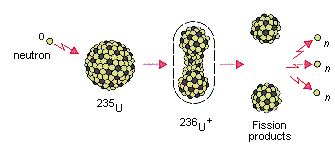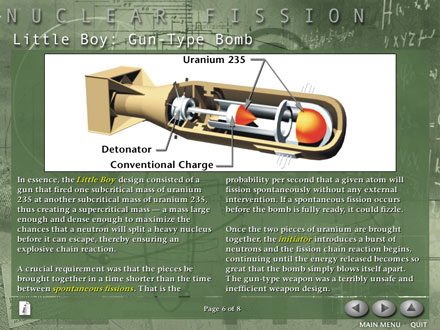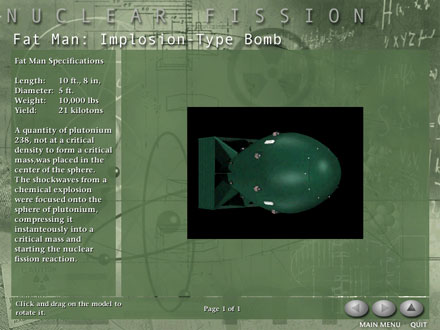Time Travel Research Center © 2005 Cetin BAL - GSM:+90 05366063183 - Turkey/Denizli
Atomic Physics: Atom bomb
Nuclear Fission and Nuclear Fusion
The graph of binding energy per nucleon
suggests that nuclides with a mass larger than about 130 amu should
spontaneously split apart to form lighter, more stable, nuclides.
Experimentally, we find that spontaneous fission reactions occur for
only the very heaviest nuclides
![]() those with mass numbers of 230 or more. Even when they do occur, these
reactions are often very slow. The half-life for the spontaneous fission
of 238U, for example, is 1016 years, or about two
million times longer than the age of our planet!
those with mass numbers of 230 or more. Even when they do occur, these
reactions are often very slow. The half-life for the spontaneous fission
of 238U, for example, is 1016 years, or about two
million times longer than the age of our planet!
We don't have to wait, however, for slow spontaneous fission reactions to occur. By irradiating samples of heavy nuclides with slow-moving thermal neutrons it is possible to induce fission reactions. When 235U absorbs a thermal neutron, for example, it splits into two particles of uneven mass and releases an average of 2.5 neutrons, as shown in the figure below.
 |
| The absorption of a neutron by 238U induces oscillations in the nucleus that deform it until it splits into fragments the way a drop of liquid might break into smaller droplets |
More than 370 daughter nuclides with atomic masses between 72 and 161 amu are formed in the thermal-neutron-induced fission of 235U, including the two products shown below.

Several isotopes of uranium undergo induced fission. But the only naturally occurring isotope in which we can induce fission with thermal neutrons is 235U, which is present at an abundance of only 0.72%. The induced fission of this isotope releases an average of 200 MeV per atom, or 80 million kilojoules per gram of 235U. The attraction of nuclear fission as a source of power can be understood by comparing this value with the 50 kJ/g released when natural gas is burned.
The first artificial nuclear reactor was built by Enrico Fermi and co-workers beneath the University of Chicago's football stadium and brought on line on December 2, 1942. This reactor, which produced several kilowatts of power, consisted of a pile of graphite blocks weighing 385 tons stacked in layers around a cubical array of 40 tons of uranium metal and uranium oxide. Spontaneous fission of 238U or 235U in this reactor produced a very small number of neutrons. But enough uranium was present so that one of these neutrons induced the fission of a 235U nucleus, thereby releasing an average of 2.5 neutrons, which catalyzed the fission of additional 235U nuclei in a chain reaction, as shown in the figure below. The amount of fissionable material necessary for the chain reaction to sustain itself is called the critical mass.
|
|
The Fermi reactor at Chicago served as a prototype for larger reactors constructed in 1943 at Oak Ridge, Tennessee, and Hanford, Washington, to produce 239Pu for one of the atomic bombs dropped on Japan at the end of World War II. As we have seen, some of the neutrons released in the chain reaction are absorbed by 238U to form 239U, which undergoes decay by the successive loss of two /i>--particles to form 239Pu. 238U is an example of a fertile nuclide. It doesn't undergo fission with thermal neutrons, but it can be converted to 239Pu, which does undergo thermal-neutron-induced fission.
Fission reactors can be designed to handle naturally abundant 235U, as well as fuels described as slightly enriched (2-5% 235U), highly enriched (20-30% 235U), or fully enriched (>90% 235U). Heat generated in the reactor core is transferred to a cooling agent in a closed system. The cooling agent is then passed through a series of heat exchangers in which water is heated to steam. The steam produced in these exchangers then drives a turbine that generates electrical power. There are two ways of specifying the power of such a plant: the thermal energy produced by the reactor or the electrical energy generated by the turbines. The electrical capacity of the plant is usually about one-third of the thermal power.
It takes 1011 fissions per second to produce one watt of electrical power. As a result, about one gram of fuel is consumed per day per megawatt of electrical energy produced. This means that one gram of waste products is produced per megawatt per day, which includes 0.5 grams of 239Pu. These waste products must be either reprocessed to generate more fuel or stored for the tens of thousands of years it takes for the level of radiation to reach a safe limit.
If we could design a reactor in which the ratio of the 239Pu or 233U produced to the 235U consumed was greater than 1, the reactor would generate more fuel than it consumed. Such reactors are known as breeders, and commercial breeder reactors are now operating in France.
The key to an efficient breeder reactor is a fuel that gives the largest possible number of neutrons released per neutron absorbed. The breeder reactors being built today use a mixture of PuO2 and UO2 as the fuel and fast neutrons to activate fission. Fast neutrons carry an energy of at least several KeV and therefore travel 10,000 or more times faster than thermal neutrons. 239Pu in the fuel assembly absorbs one of these fast neutrons and undergoes fission with the release of three neutrons. 238U in the fuel then captures one of these neutrons to produce additional 239Pu.
The advantage of breeder reactors is
obvious![]() they
mean a limitless supply of fuel for nuclear reactors. There are
significant disadvantages, however. Breeder reactors are more expensive
to build. They are also useless without a subsidiary industry to collect
the fuel, process it, and ship the 239Pu to new reactors.
they
mean a limitless supply of fuel for nuclear reactors. There are
significant disadvantages, however. Breeder reactors are more expensive
to build. They are also useless without a subsidiary industry to collect
the fuel, process it, and ship the 239Pu to new reactors.
It is the reprocessing of 239Pu that concerns most of the critics of breeder reactors. 239Pu is so dangerous as a carcinogen that the nuclear industry places a limit on exposure to this material that assumes workers inhale no more than 0.2 micrograms of plutonium over their lifetimes. There is also concern that the 239Pu produced by these reactors might be stolen and assembled into bombs by terrorist organizations.
The fate of breeder reactors in the United States is linked to economic considerations. Because of the costs of building these reactors and safely reprocessing the 239Pu produced, the breeder reactor becomes economical only when the scarcity of uranium drives its price so high that the breeder reactor becomes cost effective by comparison. If nuclear energy is to play a dominant role in the generation of electrical energy in the 21st century, breeder reactors eventually may be essential.
Although the "pile" Fermi constructed at the University of Chicago in 1942 was the first artificial nuclear reactor, it was not the first fission reactor to exist on Earth. In 1972, a group of French scientists discovered that uranium ore from a deposit in the Oklo mine in Gabon, West Africa, contained 0.4% 235U instead of the 0.72% abundance found in all other sources of this ore. Analysis of the trace elements in the ore suggested that the amount of 235U in this ore was unusually small because natural fission reactors operated in this deposit for a period of 600,000 to 800,000 years about 2 billion years ago.
The graph of binding energy per nucleon suggests another way of obtaining useful energy from nuclear reactions. Fusing two light nuclei can liberate as much energy as the fission of 235U or 239Pu. The fusion of four protons to form a helium nucleus, two positrons (and two neutrinos), for example, generates 24.7 MeV of energy.
Most of the energy radiated from the surface of the sun is produced by the fusion of protons to form helium atoms within its core.
Fusion reactions have been duplicated in
man-made devices. The enormous destructive power of the 235U-fueled
atomic bomb dropped on Hiroshima on August 6, 1945, which killed 75,000
people, and the 239Pu-fueled bomb dropped on Nagasaki three
days later touched off a violent debate after World War II about the
building of the next superweapon
![]() a fusion, or "hydrogen," bomb. Alumni of the Manhattan project, who had
developed the atomic bomb, were divided on the issue. Ernest Lawrence
and Edward Teller fought for the construction of the fusion device. J.
Robert Oppenheimer and Enrico Fermi argued against it. The decision was
made to develop the weapon, and the first artificial fusion reaction
occurred when the hydrogen bomb was tested in November 1952.
a fusion, or "hydrogen," bomb. Alumni of the Manhattan project, who had
developed the atomic bomb, were divided on the issue. Ernest Lawrence
and Edward Teller fought for the construction of the fusion device. J.
Robert Oppenheimer and Enrico Fermi argued against it. The decision was
made to develop the weapon, and the first artificial fusion reaction
occurred when the hydrogen bomb was tested in November 1952.
The history of fusion research is therefore the opposite of fission research. With fission, the reactor came first, and then the bomb was built. With fusion, the bomb was built long before any progress was made toward the construction of a controlled fusion reactor. More than 40 years after the first hydrogen bomb was exploded, the feasibility of controlled fusion reactions is still open to debate. The reaction that is most likely to fuel the first fusion reactor is the thermonuclear d-t, or deuterium-tritium, reaction. This reaction fuses two isotopes of hydrogen, deuterium (2H) and tritium (3H), to form helium and a neutron.

If we consider the implications of this reaction we can begin to understand why it is called a thermonuclear reaction and why it is so difficult to produce in a controlled manner. The d-t reaction requires that we fuse two positively charged particles. This means that we must provide enough energy to overcome the force of repulsion between these particles before fusion can occur. To produce a self-sustaining reaction, we have to provide the particles with enough thermal energy so that they can fuse when they collide.
Each fusion reaction is characterized by a specific ignition temperature, which must be surpassed before the reaction can occur. The d-t reaction has an ignition temperature above 108 K. In a hydrogen bomb, a fission reaction produced by a small atomic bomb is used to heat the contents to the temperature required to initiate fusion. Obtaining the same result in a controlled reaction is much more challenging.
Any substance at temperatures approaching 108 K will exist as a completely ionized gas, or plasma. The goals of fusion research at present include the following.
- To achieve the required temperature to ignite the fusion reaction.
- To keep the plasma together at this temperature long enough to get useful amounts of energy out of the thermonuclear fusion reactions.
- To obtain more energy from the thermonuclear reactions than is used to heat the plasma to the ignition temperature.
These are not trivial goals. The only reasonable container for a plasma at 108 K is a magnetic field. Both doughnut-shaped (toroidal) and linear magnetic bottles have been proposed as fusion reactors. But reactors that produce high enough temperatures for ignition are not the same as the reactors that have produced long enough confinement times for the plasma to provide useful amounts of energy.
A second approach to a controlled fusion reactor involves hitting fuel pellets containing the proper reagents for the thermonuclear reaction with pulsed beams of laser power. If enough power was delivered, the fuel pellets would collapse upon themselves, or implode, to reach densities several orders of magnitude greater than normal. This could produce a plasma both hot enough and dense enough to initiate fusion reactions.
|
|
Hiçbir
yazı/ resim izinsiz olarak kullanılamaz!! Telif hakları uyarınca
bu bir suçtur..! Tüm hakları Çetin BAL' a aittir. Kaynak gösterilmek şartıyla siteden
alıntı yapılabilir.
The Time Machine Project © 2005 Cetin BAL - GSM:+90 05366063183 -Turkiye/Denizli
Ana Sayfa /index /Roket bilimi / Time Travel Technology /Ziyaretçi Defteri /UFO Technology/Duyuru |



